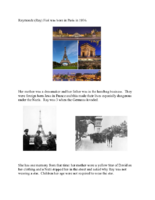Search the Special Collections and Archives Portal
Search Results

Biographical essay by Rachel Taylor, 2014
Date
Archival Collection
Description
Rachel Taylor describes her family's experience during the Holocaust in Poland in the Kutno and Gubin ghettos. She was able to escape with her sisters and brother with the help of a Polish priest and nun, and her parents survived Auschwitz-Birkenau. Taylor came to the United Staes in 1961.
Text

Biographical essay about Raymonde Fiol, 2014
Date
Archival Collection
Description
Ray Fiol is the daughter of Holocaust victims who died at Auschwitz-Birkenau. Fiol was smuggled out a labor camp and protected by a French family during the war.
Text

Biographical essay by Rudy Horst, 2014
Date
Archival Collection
Description
Rudy Horst was a prisoner at Auschwitz and was part of the Death March from Warso to Kutno, then transported to Dachau. He was liberated from the camp at Muldorf in 1944. He came to the United States in 1948.
Text

Biographical essay by Ruth Stobin, 2014
Date
Archival Collection
Description
Ruth Stobin (nee Gottschalk) was able to escape Germany in 1939 with the kindertransport to England, and came to the United States in 1941.
Text

Biographical essay by Samuel Newman, 2014
Date
Archival Collection
Description
Samuel Newman describes his experience during the Holocaust and being separated from his siblings at different orphanages. He was in Kyrgyzstan from 1943 to 1946, and at an orphanage in Poland until 1951. Newman trained in graphic arts and spent some time in the military in Israel. He came to the United States in 1968.
Text

Biographical essay by Sasha Semenoff, 2014
Date
Archival Collection
Description
Sasha Semenoff survived several internment camps during the Holocaust, and ultimately recovered and became an entertainer in Las Vegas.
Text

Biographical essay by Shirley Weiss, 2014
Date
Archival Collection
Description
Shirley Weiss describes her childhood housed in army barracks in the ghetto in Beregszasz (Berehove), Hungary. She was sent to Auschwitz-Birkenau, and several other camps, and eventually liberated from Terez?n in 1945. She came to the United States via Sweden.
Text

Biographical essay by Sidney Barouch, 2014
Date
Archival Collection
Description
Sidney Barouch describes his experience during World War II living in Tunis, Tunisia, which was a French colony. Barouch discusses the facets of the war front in northern Africa, and the experiences of his family as Jews and business owners.
Text

Biographical essay by Simone Salen, 2014
Date
Archival Collection
Description
Simone Salen's parents survived the Holocaust, and she describes her life as a miracle. She was reunited with her father's diary, which he kept during the Holocaust, and translated it into English.
Text

Biographical essay by Stan Rubens, 2014
Date
Archival Collection
Description
Stan Rubens and his family survived the Holocaust by escaping from a transport and with aid from family. They were able to stay in hiding for the duration of the war.
Text
